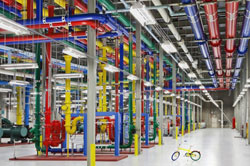However, the internet has become not a place for the realization of
postmodern utopias, but their graveyard—as the museum became a graveyard
for modern utopias. Indeed, the most important aspect of the internet
is that it fundamentally changes the relationship between original and
copy, as described by Benjamin—and thus makes the anonymous process of
reproduction calculable and personalized. On the internet, every
free-floating signifier has an address. The deterritorializing data
flows become reterritorialized.
 Google data servers
Google data servers
Walter Benjamin famously distinguished between the original, which is
defined through its “here and now,” and the copy, which is siteless,
topologically indeterminable, lacking a “here and now.” Contemporary
digital reproduction is by no means siteless, its circulation is not
topologically undetermined, and it does not present itself in the form
of a multiplicity as Benjamin described it. Every data file’s address on
the internet accords it a place. The same data file with a different
address is a different data file. Here the aura of originality is not
lost, but instead substituted by a different aura. On the internet, the
circulation of digital data produces not copies, but new originals. And
this circulation is perfectly traceable. Individual pieces of data are
never deterritorialized. Moreover, every internet image or text has not
only its specific unique place, but also its unique time of appearance.
The internet registers every moment when a certain piece of data is
clicked, liked, un-liked, transferred, or transformed. Accordingly, a
digital image cannot be merely copied (as an analogue, mechanically
reproducible image can) but always only newly staged or performed. And
every performance of a data file is dated and archived.
Boris Groys ///Art Workers: Between Utopia and the Archive



No comments:
Post a Comment